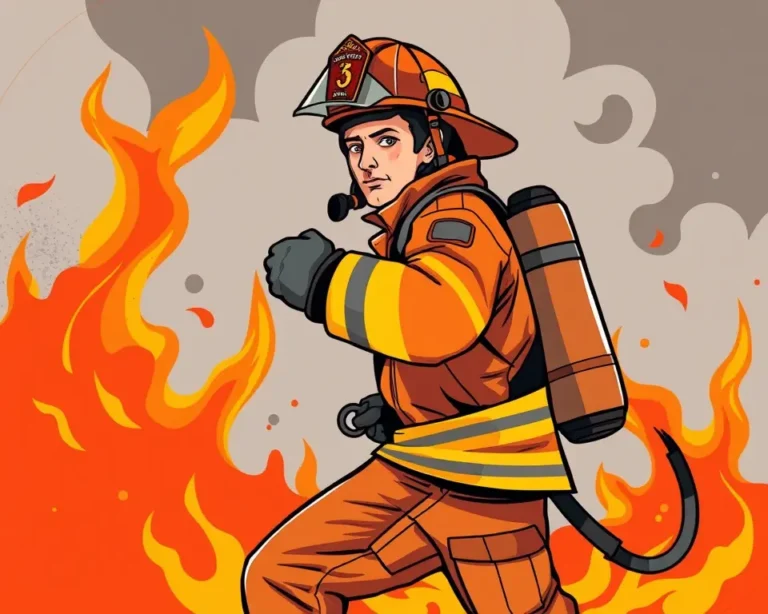Firefighters face extraordinary physical demands, battling fires and rescuing people in high-stress environments. The job inherently carries a high risk of injury, but targeted fitness programs are proving to be a game-changer in keeping these everyday heroes healthy and on the job. Several fire departments are working with strength coaches and trainers with a goal of helping them stay strong, healthy and safe.
The Toll of the Trade: Understanding Firefighter Injuries
Before diving into solutions, it’s important to understand the scope of the problem. Firefighting is consistently ranked among the most dangerous professions.
- High Injury Rates: Municipal firefighters experienced 63,175 injuries in 2023.
- Common Injuries: Sprains, strains, and muscular pain are the most prevalent types of injuries, often caused by overexertion, falls, jumps, and slips. Fire or chemical burns are also a major concern.
- Location of Injuries: Fireground operations are the most common location for injuries.
- Lost Time: A significant percentage of fireground injuries result in lost work time.
- Exposure: Firefighters are regularly exposed to hazards such as heat, smoke, and toxic agents.
- Costly Injuries: If one firefighter is out for a few months, that would cost more than the fitness program itself costs. So the reduction in injury is important.
Understanding these factors is the first step in designing effective prevention strategies.
Building a Better Firefighter: The Core Components of Injury Prevention Programs
Modern firefighter fitness programs go far beyond basic exercise. They are comprehensive, science-backed initiatives designed to address the specific demands of the job.
Comprehensive Fitness Assessments
The NFPA 1582 guidelines outline specific medical tests and physical examinations that firefighters must undergo, both when joining the department and annually thereafter.
- Aerobic Capacity: Measuring heart rate stress and recovery speed after exercise.
- Body Composition: Assessing body mass index (BMI) and skinfold tests.
- Grip Strength: Testing the firefighter’s ability to carry hoses and lift heavy objects.
- Leg Strength: Evaluating leg strength.
- Muscular Endurance: Measuring the ability to perform repetitive muscle contractions over time.
- Flexibility: Evaluating range of motion in major joints to prevent strains and sprains.
Targeted Exercise Regimens
These programs incorporate a variety of exercises tailored to the unique challenges firefighters face:
- Strength Training: Focuses on building overall strength and power, particularly in the core, back, and legs. Exercises like squats, deadlifts, sled drags, and farmer walks are commonly used.
- Cardiovascular Conditioning: Improves endurance and stamina, essential for prolonged operations. Circuit training that stresses both muscular and cardiovascular systems has been shown to be beneficial. Stair climbing with packs, battle ropes using hoses, and high-intensity interval training are effective methods.
- Functional Movements: Mimic real-world firefighting tasks. Examples include carrying heavy weights, dragging hoses, climbing stairs, and using tools.
- Flexibility and Mobility: Improves range of motion and reduces the risk of strains and sprains.
- Core Strengthening: Crucial for stability and injury prevention, especially during physically demanding tasks.
- Fireground Interval Circuits: Aerodyne (if you don’t have an aerodyne, you can use a row machine or battling hoselines), Jumping jacks or Weighted Jump Rope, Stair Crawling (bear crawl up the stairs then run back down), Sledges on a tire (overhead and side sledges) or medicine ball slams, Core Exercise (plank, bird-dog), and Mountain Climbers (or burpees).
The Importance of Periodization
Both linear and undulating periodization training has been shown to improve fitness levels and job performance in novice firefighters. Circuit training can be easily incorporated with limited equipment and in large group settings while on shift.
Education and Training
Beyond the physical aspects, these programs emphasize education on:
- Proper lifting techniques: To minimize back injuries.
- Ergonomics: To reduce strain during everyday tasks.
- Nutrition: To fuel the body for optimal performance and recovery.
- Hydration: To prevent heat stress and fatigue.
The Mental Game
The responsibilities in a firefighter’s line of work include many dangerous situations. Racing towards a raging fire rather than away from it takes some serious mental fortitude.
- Behavioral Health Support: Acknowledging the diverse health risks firefighters face in their roles. The ERS proposal advocates for updated requirements for emergency responder readiness, such as apparatus and protective clothing standards. Additionally, the ERS seeks to establish mandatory behavioral health support and medical screenings, a move the IAFF asserts will safeguard firefighters from occupational health risks.
Making it Happen: Implementing Successful Programs
While the benefits of firefighter fitness programs are clear, successful implementation requires careful planning and commitment.
Leadership Buy-In
Support from fire chiefs and union leaders is essential for creating a culture of wellness. The Fire Service Joint Labor Management Task Force created the Wellness/Fitness Initiative (WFI) is to improve quality of life for all firefighters. The project seeks to prove the value of investing wellness resources over time to maintain a fit, healthy and capable firefighter throughout his/her 25-30 +years of service.
Dedicated Resources
Adequate funding, qualified personnel (trainers, coaches, and medical professionals), and appropriate facilities are necessary. Fire departments need to implement robust health and wellness initiatives that address both the physical and mental health needs of firefighters. These programs should include regular health screenings, access to mental health counseling services, fitness and nutrition programs, and education on recognizing and managing stress.
Program Tailoring
Programs should be tailored to the specific needs and demographics of the fire department.
Ongoing Evaluation
Regular assessments and data collection are crucial for monitoring progress and making adjustments.
National Standards and Initiatives
Several organizations are leading the charge in promoting firefighter health and safety:
- NFPA 1583: Standard on Health-Related Fitness Programs for Fire Department Members, outlines a health-related fitness program that is designed for fire departments.
- IAFF/IAFC Wellness-Fitness Initiative: A comprehensive program addressing medical evaluations, fitness, rehabilitation, behavioral health, and data collection.
- Emergency Response Standard (ERS): The proposal mandates baseline medical screenings and behavioral health access, acknowledging the diverse health risks firefighters face in their roles. The IAFF emphasized that ERS would advance safety not only for the firefighters but also for the communities they serve by enhancing emergency response preparedness.
The Future of Firefighter Safety
Firefighter injury prevention is not just a trend, but a necessary evolution in the fire service. By embracing comprehensive fitness programs, fire departments can:
- Reduce injuries and lost work time.
- Improve firefighter health and well-being.
- Enhance operational effectiveness.
- Lower healthcare costs.
- Extend firefighter careers.
- Improve morale and job satisfaction.
The ultimate goal is to ensure that firefighters are physically and mentally prepared to handle the challenges they face, protecting both themselves and the communities they serve.







